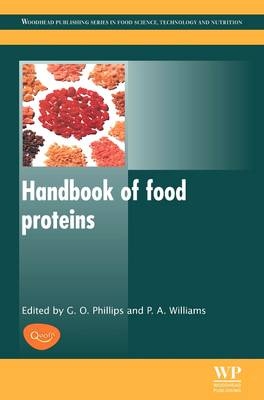
Handbook of Food Proteins
Woodhead Publishing Ltd (Verlag)
978-0-08-101669-5 (ISBN)
The introductory chapter provides an overview of proteins and their uses in foods. The following chapters each focus on a particular protein ingredient or group of ingredients covering their origins, production, properties and applications. The proteins discussed are caseins, whey proteins, gelatin and other meat-derived protein ingredients, seafood proteins, egg proteins, soy proteins, pea and other legume proteins, mycoprotein, wheat gluten, canola and other oilseed proteins, algal proteins and potato protein. A chapter on texturised vegetable proteins completes the volume. Innovative products and potential methods for improving nutrition and diet using these proteins are described.
With its distinguished editors and international team of expert contributors Handbook of food proteins is an invaluable reference tool for professionals using food protein ingredients for both food and other applications.
Professor Glyn O. Phillips was Professor of Chemistry at the University of Salford and appointed as Executive Principal of the North East Wales Institute (now Wrexham Glyndwr University) in 1976. He is a Fellow of the Learned Society of Wales and was awarded an honorary degree of Doctor of Science by the University of Benin in 1990 and an honorary degree of Doctor of Laws by the University of Wales in 1999. He was awarded the A.G. Evans Medal by the University of Cardiff in 1991, the first Science and Technology Medal by the National Eisteddfod of Wales in 2004 and the Food Hydrocolloids Trust Medal in 2007. He has a broad range of scientific interests and has published more than 600 research papers in areas including radiation and free radical chemistry, radiation sterilisation, photochemistry and carbohydrate and polysaccharide chemistry. He was technical adviser to the International Atomic Energy Agency and editor of the journals, Food Hydrocolloids, Advances in Tissue Banking and International Journal of Cell and Tissue banking. He initiated the Gums and Stabilisers for the Food industry series of Conferences in 1981 and established the Phillips Hydrocolloids Research Centre at Wrexham Glyndwr University in 2003. Peter A. Williams is Professor of Polymer and Colloid Chemistry and Director of the Centre for Water Soluble Polymers at Wrexham Glyndwr University. He was awarded the degree of Doctor of Philosophy by the University of Salford in 1982 and Doctor of Science in 2009. He is a Fellow of the Royal Society of Chemistry and a Chartered Chemist. He has over 35 years research experience in the chemical modification, physicochemical characterisation, rheological properties and interfacial behaviour of hydrocolloids. He has published over 230 research papers and edited 42 books. He is co-founder and Editor-in-Chief of the international journal Food Hydrocolloids which was launched in 1986. He has been involved in the organisation of more than 40 international conferences on behalf of the Food Hydrocolloids Trust, the Cellucon Trust the Royal Society of Chemistry and the Society of Chemical Industry. He is a past Chairman of the Society of Chemical Industry Surface and Colloids Group and past Treasurer of the Royal Society of Chemistry Colloid and Interface Science Group. He was awarded the SCI Distinguished Service award in 2007 and the Food Hydrocollloids Trust Medal in 2013.
Contributor contact details
Woodhead Publishing Series in Food Science, Technology and Nutrition
Preface
Chapter 1: Introduction to food proteins
Abstract:
1.1 Introduction
1.2 Structure of protein
1.3 Functional properties of proteins
1.4 Scope of this book
Chapter 2: Caseins
Abstract:
2.1 Introduction
2.2 Manufacture of casein-based ingredients
2.3 Structure and properties
2.4 Uses and applications of casein-based ingredients
2.5 Interactions with other ingredients
2.6 Technical data and specifications
2.7 Regulatory status
Chapter 3: Whey proteins
Abstract:
3.1 Introduction
3.2 Manufacture of whey protein ingredients
3.3 Chemistry of the major whey proteins
3.4 Technical data
3.5 Uses and applications of whey protein ingredients
3.6 Whey protein hydrolysates
3.7 Regulatory status
3.8 Future trends
3.9 Sources of further information and advice
3.10 Acknowledgements
Chapter 4: Meat protein ingredients
Abstract:
4.1 Introduction
4.2 Sources of meat protein ingredients
4.3 Lean tissue protein ingredients
4.4 Connective tissue protein ingredients
4.5 Hydrolysates and flavors
4.6 Blood protein ingredients
4.7 Future trends
4.8 Acknowledgment
Chapter 5: Gelatin
Abstract:
5.1 Introduction
5.2 Manufacturing gelatin
5.3 Regulations, technical data and standard quality test methods
5.4 Chemical composition and physical properties of collagens and gelatins
5.5 Gelatin derivatives
5.6 Applications of gelatin
5.7 Acknowledgements
Chapter 6: Seafood proteins
Abstract:
6.1 Introduction
6.2 Chemistry of seafood proteins
6.3 Seafood proteins as a component of the human diet
6.4 Comparison of seafood proteins with vegetable and other animal proteins
6.5 Functional properties of seafood proteins
6.6 Factors affecting functional properties of seafood proteins
6.7 Isolation and recovery of fish muscle proteins from whole fish and fish processing by-products
6.8 Products derived from seafood proteins
6.9 Environmental considerations for continuous sustainability of proteins from aquatic resources
6.10 Regulatory aspects of seafood protein: allergies to seafood proteins
Chapter 7: Egg proteins
Abstract:
7.1 Introduction
7.2 Egg white: chemical composition and structure
7.3 Manufacture of egg white ingredients
7.4 Functional properties of egg white
7.5 Conclusion: egg white
7.6 Egg yolk: chemical composition and structure
7.7 Manufacture of egg yolk ingredients and egg yolk separation
7.8 Functional properties of egg yolk
7.9 Conclusion: egg yolk
7.10 Regulatory status: egg proteins as food allergens
Chapter 8: Soy proteins
Abstract:
8.1 Introduction
8.2 Soybean storage proteins: structure-function relationship of β -conglycinin and glycinin
8.3 Soy protein as a food ingredient
8.4 Improving soy protein functionality
8.5 Conclusion
Chapter 9: Peas and other legume proteins
Abstract:
9.1 Introduction
9.2 Processing and protein isolation
9.3 Characterization of pea and other legume proteins and isolates
9.4 Functional properties in isolates and ways of improving them
9.5 Utilization of pea and other legume proteins in foods
9.6 Future challenges and trends in using peas and other legume proteins
Chapter 10: Wheat gluten: production, properties and application
Abstract:
10.1 Introduction
10.2 World production and trade
10.3 Wheat gluten manufacturing processes
10.4 Composition and protein structure
10.5 Functional and sensory properties
10.6 Modification of gluten for new functional properties
10.7 Uses and applications of wheat gluten
10.8 Regulatory status and gluten intolerance
10.9 Future trends
Chapter 11: Canola and other oilseed proteins
Abstract:
11.1 Introduction
11.2 Processing and protein isolation
11.3 Characterization of canola and other oilseed proteins and isolates
11.4 Functional properties
11.5 Utilization of canola and other oilseed proteins
11.6 Issues in using canola and other oilseed proteins
Chapter 12: Potato proteins
Abstract:
12.1 Introduction
12.2 Physico-chemical properties of the different potato proteins
12.3 Functionality of different types of potato proteins
12.4 Potato protein isolation
12.5 Specifications of industrially produced potato protein preparations
12.6 Uses and applications
12.7 Regulatory status and safety
Chapter 13: Mycoprotein: origins, production and properties
Abstract:
13.1 Introduction
13.2 Manufacture of mycoprotein
13.3 The production of foods from mycoprotein
13.4 Texture creation in mycoprotein
13.5 Nutritional properties of mycoprotein
13.6 Regulatory status
13.7 Future trends: mycoprotein and sustainability
Chapter 14: Algal proteins
Abstract:
14.1 Introduction
14.2 Cultivation and production of algae and algal proteins
14.3 Composition of algal proteins
14.4 Extraction procedures and processing of algal proteins
14.5 Functional properties of algal proteins
14.6 Nutritional quality of algal proteins
14.7 Toxicological and safety aspects
14.8 Utilisation of algal proteins
14.9 Future trends
Chapter 15: Texturized vegetable proteins
Abstract:
15.1 Introduction
15.2 Raw materials for textured vegetable protein
15.3 Soy processing to generate raw materials for texturization
15.4 Processing other crops to generate raw materials for texturization
15.5 Processes for making textured vegetable protein
15.6 Types of textured vegetable proteins
15.7 Uses of texturized vegetable protein
Index
| Erscheinungsdatum | 27.07.2016 |
|---|---|
| Reihe/Serie | Woodhead Publishing Series in Food Science, Technology and Nutrition |
| Verlagsort | Cambridge |
| Sprache | englisch |
| Maße | 156 x 234 mm |
| Gewicht | 640 g |
| Themenwelt | Sachbuch/Ratgeber ► Essen / Trinken ► Grundkochbücher |
| Sachbuch/Ratgeber ► Gesundheit / Leben / Psychologie ► Ernährung / Diät / Fasten | |
| Technik ► Lebensmitteltechnologie | |
| ISBN-10 | 0-08-101669-7 / 0081016697 |
| ISBN-13 | 978-0-08-101669-5 / 9780081016695 |
| Zustand | Neuware |
| Haben Sie eine Frage zum Produkt? |
aus dem Bereich


